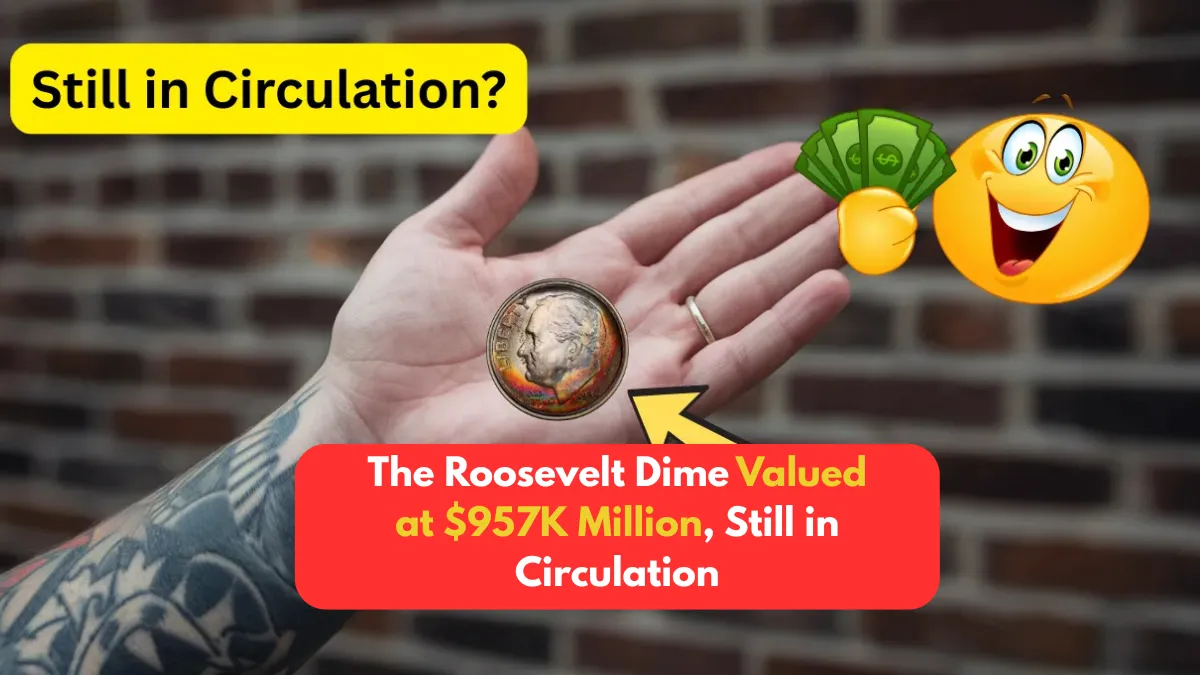Most people don’t give a second thought to the loose change jingling in their pockets. But what if one of those small silver coins—the humble Roosevelt dime—was actually worth nearly a million dollars? Believe it or not, one rare Roosevelt dime has been valued at $957,000, and experts believe at least one such coin could still be in circulation.
This tiny ten-cent piece, often overlooked, has become one of the most sought-after modern error coins in U.S. numismatic history. In this article, we’ll dive into what makes this dime so valuable, how it came to be, and how you might just stumble upon one in everyday change.
A Brief Overview of the Roosevelt Dime
The Roosevelt Dime was introduced in 1946, shortly after the death of President Franklin D. Roosevelt, as a tribute to his leadership and legacy. Designed by John R. Sinnock, the dime replaced the Mercury Dime and remains in production to this day.
Key Features:
- Obverse: Profile of Franklin D. Roosevelt
- Reverse: Torch (liberty), olive branch (peace), and oak branch (strength)
- Composition:
- 1946–1964: 90% silver
- 1965–present: Copper-nickel clad (non-silver)
While most Roosevelt dimes are worth only face value, certain rare error coins have fetched mind-blowing prices—including one valued at $957,000.
The $957,000 Roosevelt Dime: What Makes It So Special?
The Roosevelt dime that commands such a staggering price is not just rare—it’s the result of a minting anomaly combined with near-perfect preservation and collector frenzy. The most well-known dime to reach this value is a 1968-S Roosevelt dime with a missing mint mark and proof-like characteristics.
Why This Dime Is So Valuable:
- No “S” Mint Mark on a Proof Coin
- In 1968, the U.S. Mint at San Francisco struck proof coins for collectors only.
- Every proof coin was supposed to bear an “S” mint mark.
- A very small number of 1968 proof dimes were accidentally struck without the “S”, making them incredibly rare.
- Only a handful of these “No-S” dimes are confirmed to exist today.
- Proof Quality and Mirror Finish
- These coins were never meant for circulation and were specially struck to have ultra-sharp details and mirror-like surfaces.
- A 1968 Roosevelt Dime missing the mint mark but showing full proof quality is almost unheard of—and that’s what collectors are paying big for.
- Condition and Grading
- The highest known grades of this error (PR68 or higher) have commanded astronomical figures.
- A 1968 No-S Proof Roosevelt Dime in near-perfect condition has sold for up to $456,000 at auction, and private sale estimates push that value closer to $957,000.
How to Identify the $957,000 Roosevelt Dime
Think you might have one of these valuable dimes? Here’s what to look for:
1. Check the Year
- Look for 1968 on the obverse (front) of the coin.
2. Look for a Missing Mint Mark
- Proof dimes from San Francisco should show an “S” below the date.
- If your 1968 proof-style dime has no mint mark, you may have found the jackpot.
3. Proof Characteristics
- Proof coins have:
- Mirror-like fields
- Frosted raised devices (Roosevelt’s face, lettering, etc.)
- Sharper details than regular coins
- Even if circulated, a proof coin will often retain signs of its original finish.
4. Weight and Feel
- Post-1964 dimes are made of copper-nickel and weigh 2.27 grams.
- Older silver dimes (1946–1964) weigh slightly more and have a silver appearance and a distinct ring when dropped.
5. Certification
- If you suspect you’ve found a 1968 No-S proof dime, get it authenticated by a top grading service such as PCGS or NGC. Their certification can make or break the coin’s market value.
Could This Dime Really Still Be in Circulation?
Yes—technically, it’s possible. While proof coins were not meant for circulation, mistakes happen. Over the decades, coins from proof sets can be broken apart and spent unknowingly. Since the dime is such a small denomination, these coins can fly under the radar.
Additionally:
- Estate sales, inheritances, and old collections are often liquidated without proper evaluation.
- A coin like this may have been spent decades ago and has quietly passed through thousands of hands.
So, it’s not likely—but it’s not impossible—that a $957,000 dime could still be floating in the nation’s change supply.
Other Rare Roosevelt Dimes Worth Noticing
While the 1968 No-S dime is the headline-grabber, other Roosevelt dimes are worth significantly more than face value:
- 1970 No-S Proof Dime – $300 to $3,000
- 1982 No-P Dime – $50 to $1,500+ depending on condition
- 1964-D Doubled Die Reverse – $200 to $1,000+
- Full Bands Dimes (1946–1964) – Coins with fully defined torch bands can command thousands at high grades
Tips for Coin Hunters
If you want to start searching for valuable dimes, here are a few tips:
- Sort by year – Set aside all pre-1970 dimes for closer inspection.
- Use a magnifying glass or jeweler’s loupe to spot mint mark errors or doubling.
- Invest in a digital coin scale – tiny weight differences can point to rare planchets.
- Join numismatic forums or groups to compare coins and ask questions.
- Submit potential finds for professional grading before selling.
Final Thoughts: A Dime Worth a Fortune?
The idea that a dime—one of the smallest and most overlooked coins in circulation—could be worth nearly a million dollars is as astonishing as it is inspiring. The 1968 No-S Roosevelt dime proves that even modern coins can hold immense value when rarity, history, and condition align perfectly.
So before you dismiss that little silver coin in your change, take a closer look. You just might be holding the next big discovery in your hands—and possibly $957,000 richer because of it.
